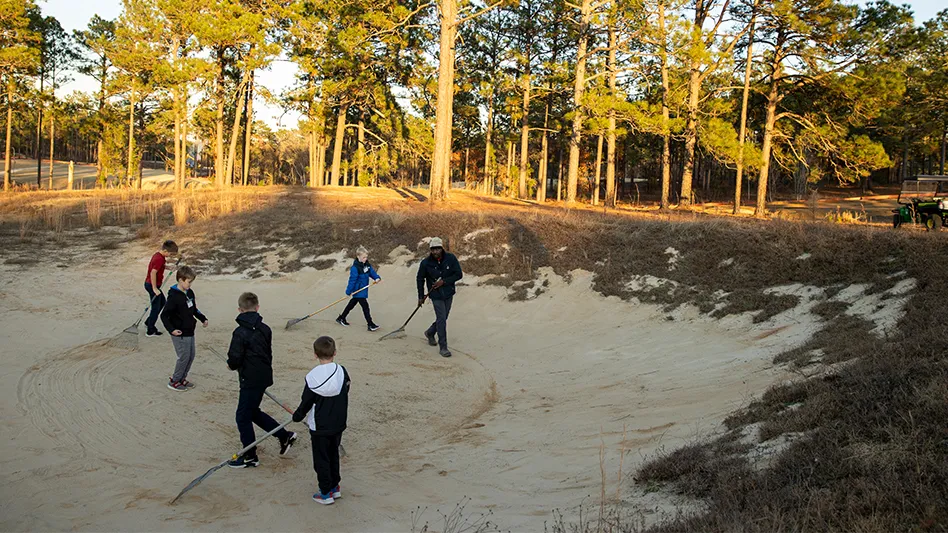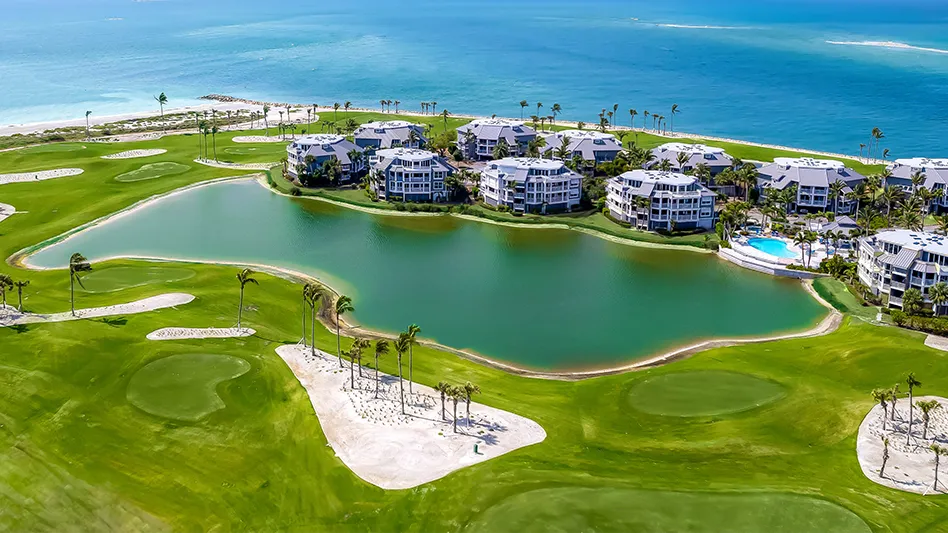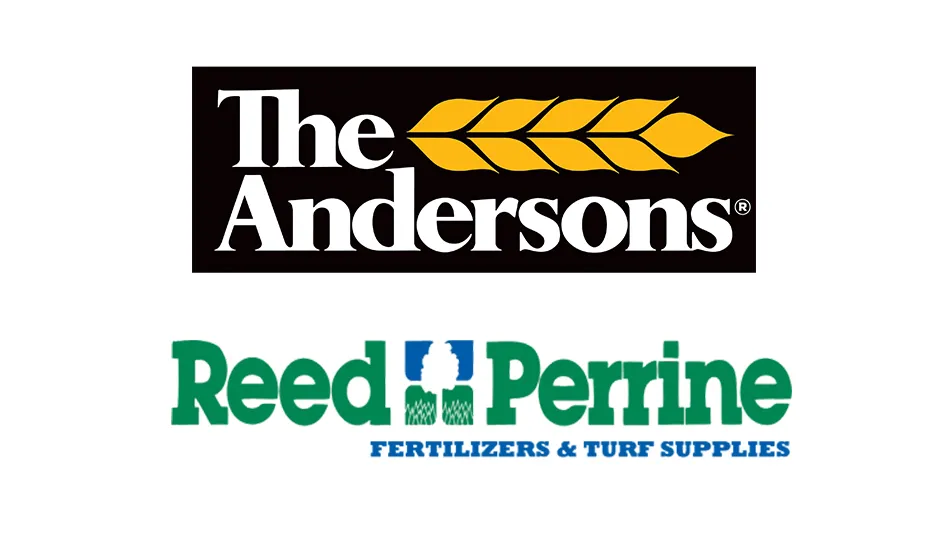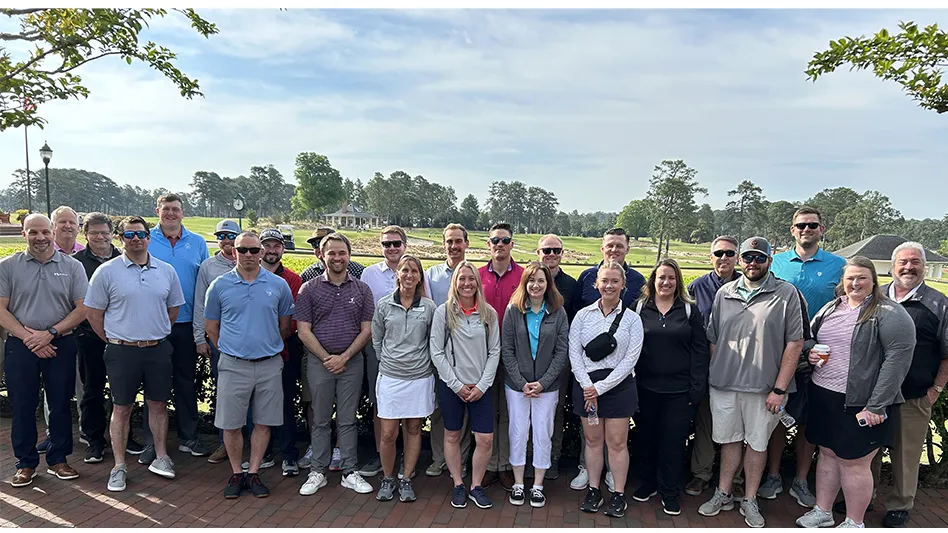
Just as a masterpiece painting is improved using the finest bristled paintbrushes rather than a spatula, so sometimes the most dramatic improvements to a golf course can be achieved by the simplest touch: altering grass lines.

“Surely, you can argue that if you reroute golf holes, or reverse them, or take them onto adjacent land, or blow up entire greens complexes, those are dramatic changes. But they’re also very disruptive,” says golf course architect Raymond Hearn, ASGCA. “Greens, tees and bunkers typically take the spotlight in golf course restoration and remodeling. But grass-line changes — sometimes the finest touches of all — can accomplish maximum, and even powerful, results with minimal amount of work.”
The bonus, Hearns adds, is that “everyone can do this — from private clubs to public courses, munis and resorts.”
The proof is at Washtenaw Golf Club (1899) in Ypsilanti, Michigan; Metedeconk National Golf Club (1987) in Jackson, New Jersey; and Midlothian Country Club (1898) in Midlothian, Illinois, among others.
Midlothian and Metedeconk were both grass-line and bunker projects, “so the angles and options there were completed by flipping fairways this way or creating or extending great runoff areas, and while doing that, adjusting this bunker or that bunker,” Hearn says. “At Washtenaw, it was 100 percent grass-line improvements.”
“We didn’t want to make drastic changes and blow up a Robert Trent Jones Sr. golf course,” says Metedeconk general manager Derek Kopp. “All of Ray’s fairway-line and bunker changes and bentgrass areas around the greens increased shot values, created a lot more options, and provided a fresh, modern look.
“When you make these changes and alter the grass lines, you increase shot values and strategy as Ray promised and delivered. Here, it almost softens the course a bit for the higher-handicapper, but maintains the level of difficulty for the scratch golfer.”
“It’s like fixing a bad haircut,” says Dave Kendall, PGA professional and part-owner at Washtenaw. “We didn’t have to tear it all down and rebuild it. We’ve learned some things over the last two years that will help us in the future.”
At Midlothian, club historian Mark Wheeler, a past president who chairs the club’s restoration committee, declares that Hearn’s grass-line changes on holes 4 and 6, in particular, dramatically improved play and “made the golf course look bigger.”
“It appears more manicured — a classic look,” he says, “and everybody absolutely loves it.”
“All superintendents involved with each project” — Mark Pappas at Washtenaw, Andrew Mallick at Metedeconk, Chris Flick at Midlothian and Cory Von Tungein, the previous superintendent at Midlothian — “have done a terrific job,” Hearn says, “and Mark’s work turning that amount of rough into fairway on No. 11 at Washtenaw was masterful and extraordinary.”
Lower cost, better playability
Some may consider changing grass lines simply to reduce the costs of mowing and maintenance.
“This can be true,” Hearn says, “but what you do too often is create plain vanilla ice cream. I’m saying you can save money in mowing and spraying but at the same time you can create more angles and options — a new look without spending all the money on new greens, new bunkers, irrigation, etc.
“On many holes, we remove fairway from one area but add it elsewhere if it improves sightlines and play-angle choices, heightening the golfing experience.”
While bunker work and tree removal are often included in these restorations, Hearn says grass lines are the most crucial and least expensive in impacting play options.
At Metedeconk, Mallick says, “Shot variety has been greatly improved around fairway edges and especially next to green complexes. Players have more options: chipping, putting, laying up, punching, flopping. And that has reinvigorated our membership. They love Ray’s improvements. Along with playability, aesthetically, these changes force players to think more carefully about their next shot.”
How it’s done
Hearn gives accolades to Google Earth technology, with the ability to clearly show aerial views of each hole on a course as it stands. His team Photoshops into those aerial photographs his proposed grass-line and other adjustments, showing what they would look like.
“At private clubs, this gets members excited,” he says. “At public courses, it gets patrons enthused. The next step is when the project’s complete, we do the actual before-and-after aerials. Our Photoshop before-and-after images look so real it’s almost the same.”
Hearns takes his strategy from famed golf course architects C.B. Macdonald and Alister Mackenzie, who often declared that architecture, when reduced to its simplest form, is “thoughtful angles and options for a variety of players.”
“When looking at an aerial, I immediately judge the golf hole by its different angles and options that are available — initially based on tree lines and grass lines,” Hearn says. “On those sites that are overplanted, the grass lines have to be thought of at the same time as tree removal. On courses that are not overplanted, or are links-style with few trees, it’s easier to look at the aerial photo and focus on the angles and options of just the grass lines.”
“At some courses, I ask, ‘Why, in this area of the hole, does the fairway have to be so wide? Let’s narrow it and use that fairway we’re removing and move instead to more strategic parts of the hole. Perhaps I can increase an angle, or option, or width at a landing zone with multiple attack options, or add a widened strategic run-up area to the green or new run-off area beside a green. Sometimes we can eliminate a stereotypical string of bunkers and create a new ground-game feed to the front of the green.”
Examples abound.
Washtenaw No. 11
Washtenaw’s 11th hole, for instance.
“It’s incredible what Mark Pappas, the superintendent, has done,” Hearn says.
Pointing to the 11th hole, and to the new left green run-off area, in particular, he adds, “It’s like you’re building a new home. You have to have the foundation set before proceeding. Here, the foundation was establishing the grass lines. New green edges were also instituted, the lost corners of the green were found, and the fairway edges have been restored to early 1900 images.”
The fairway cut to the left of the 11th green and three new bunkers took 18 months of scalping, overseeding and watering, but it was worth the effort, Pappas says. “You can scalp two inches down to a half-inch fairly easy. But you can’t scalp to square the greens. Going from a half-inch down to an eighth or lower doesn’t work.
“In the future, when we do more greens, I’m going to just sod the corners and get it out of the way.”
Meanwhile, Pappas says that while he has in the past had four heights of cut around the green edges, that will change.
“It was just too busy,” he says. “Now we mow green height, the collars with triplex mowers, fairway heights, then roughs. Doing that, we either take the green out wider or have really wide collars. It looks neat and creates a lot more options. Before, you could only flop out of there. Now golfers have more options and can play to their strengths. I appreciated Ray’s creativity.”
Midlothian’s No. 1
Another prime illustration of grass-line changes is the first hole at Midlothian, where the course remained open while contractors rebuilt bunkers and recontoured fairway lines under Hearn’s guidance without disrupting play.
Wheeler, a long-time member of the club, calls the changes “stunning,” pointing especially to added runoff areas around seven of the greens and returning a number of the putting surfaces to their original square shape.
“Really,” Von Tungein, the former superintendent, says, “the main thing is that we were able to shave off a decent amount of fairway that wasn’t being used — like the first 30 to 40 yards of the fairway where nobody ever hits the ball — and use that grass to help create other grass lines and runoff, new angles, runways. That was the core fundamental for me. We didn’t have to purchase sod, just flip it from one area to another part of the fairway to change the contour and line of that fairway.”
“It’s amazing what you can accomplish just by moving some dirt around, too,” Wheeler says. “Ray created new tee boxes that showcase some very unique angles off the tee shot. And, like the mowing changes, the cost was minimal.”
Flick says, “Ray’s grass lines define the course’s historic features and new creative play angles. They also create sense and streamline our work from a maintenance perspective. I love how they look.”
Hearn explains the two fairway bunkers were “floating off the site, on hole No. 1,” so he replaced them with two that are in play for mid-range and lower-handicap golfers. And by removing the greenside bunkers and replacing them with one that partially fronts just the left side of the green, he was able to add “a thrilling bump-and-run avenue into the green and an exciting new run-off area.”
Eliminating the right greenside bunker created “a wonderful runoff area that has a slight depression,” Hearn explains. “So, when you miss the approach shot and roll down into this area, now you have four dramatic recovery options: you can pitch it, lob it, putt it or chip it. How exciting is that in terms of recovery‚ multiple options plus considering where you are in your match, the wind conditions, is it wet or dry? That’s exciting golf.”
With all these changes, Hearn adds, “the star of the show is the grass lines.”
Metedeconk’s 7th, a masterclass
Hearn calls No. 7 at Metedeconk “a master class in grass-line changes.”
A sophisticated membership wanted to take the course from good to great. On No. 7, a significant portion of the bunkers was replaced by fairway and a new green run-off area that “increases the shot value and adds an intimidation factor,” Hearn says.
“In the past,” Kopp, the general manager, says, “you’d simply aim for the bunker at 250 yards, then hit your second shot out of the rough onto the green. Now, it creates that visual drama that the ball could roll into the bunker. It changes the dynamic.”
Replacing the rear greenside bunker, Mallick adds, was a controversial move. “But once the work was complete it didn’t take much convincing to proceed in Ray’s advised direction on other areas of the course. Shockingly, even the naysayers were on board.”
Artwork
“To a degree, golf courses are works of art,” Hearn says. “I’m putting up an aerial image on my ‘paintboard.’ I’m taking out my smallest paintbrush. I’m painting these adjustments that are like fine-tuning a piece of art that’s already well-received. This is carefully thinking out every paintbrush stroke.
“And what I find interesting is how powerful these grass-line adjustments are.”

Explore the October 2022 Issue
Check out more from this issue and find you next story to read.
Latest from Golf Course Industry
- USGA opens Golf House Pinehurst
- Bernhard Academy expands leadership team
- Another record year for research
- The Highlands pays more homage to Ross
- Audubon International adds veteran superintendent to leadership team
- South Florida simmer
- Devising safer landings
- SiteOne adds Durentis to product offerings





